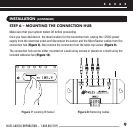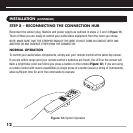
18
INSTALLATION CONTINUED
When you don’t have access above or below the wall, try to estimate the existing cable and pipe
locations from the positions of electrical outlets and plumbing fixtures on both sides of the wall.
Also, take a look at the outside of your house, sometimes a conduit, vent or drain pipe will be visible
and will offer useful information. Choose the route with the fewest potential obstacles. If your house
is built on a slab or you are wiring between two finished floors, look for baseboards which could
be removed and replaced with the cable behind them. Doorjambs can be removed and often have
enough space for sensor cable all the way around the door (Figure 15).
Sometimes, an under-the-carpet run is possible. As a last resort, heating and air conditioning vents
can be used as cable raceways for plenum rated cable (check your local building codes, some
municipalities require a conduit)
When you are dealing with the unknown because of the structure of your home, or with difficult
materials to patch the wall, such as plaster, lath and plaster, faux finishes, wallpaper etc., be
patient. A careful study of the potential problems before you start the job will pay off later.
Figure 15: Routing Wire Around a Door


















